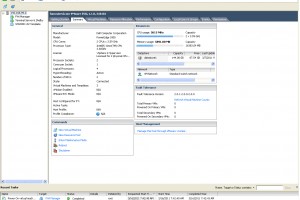 I had some vacation recently so I did what anyone does on vacation…think about work 🙂
I had some vacation recently so I did what anyone does on vacation…think about work 🙂
We have a Dell PowerEdge 1800 that was donated to us by a member of First Church. Since receiving it I pulled the existing Xeon 2.8Ghz process and 4GB of RAM (not bad) and installed Dual 3.6GHz Xeon processors, 2 Intel network interface cards, and the maximum amount of 16GB of RAM (way better). What for? You ask. We are going virtual.
This is not new technology, in fact tons of organizations already have virtual machines. However, many churches trail this trend.
If you are not familiar, virtualization allows you to install multiple operating systems (OS) on the same physical hardware. Since most computers don’t utilize all of their processing power this is a way to get more bang for your buck, a lot more.
I chose to use VMware’s ESXi 4.1 host OS. This is a tiny OS that installs from a CD onto the server. VWware makes it available for FREE! They have other versions with more features and support which cost money. Version 4.1 was necessary since it is compatible with the Dell 1800, the NICs, and Adaptec RAID card. The screenshot above is from vSphere Client. This is an application installed on a networked computer to allow administration of the ESXi host. Within this application you can allocate resources to multiple instances of different operating systems. We are a Windows shop so I have installed 3 additional Windows servers each with varying amounts of RAM, drive space, and video memory. I kept one server as a template file in case I need to quickly create another Windows Server 2008 instance. If needed I can copy and paste this template and have a full fledged server up in running in no time. This is especially helpful for disaster recovery.
So far I have been very impressed. The two servers running on this box are currently in production. One runs our accounting software and Terminal Server the other drives a content manager for our digital signage project.
If you are looking to deploy your own virtual server host here are some things to look out for:
- Make sure your hardware is on the compatibility list – this was the reason for purchase additional NICs
- Your guest OSes can only be 64bit if your processor supports Virtualization Technology (VT) – the PowerEdge 1800 does not, so I am stuck in 32 bit land 🙁
- Have plenty of RAM
